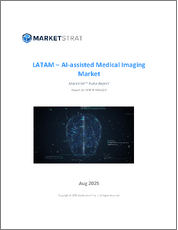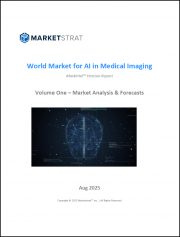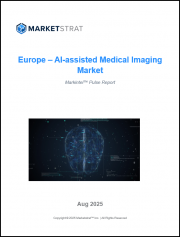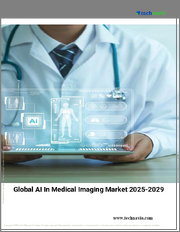
|
시장보고서
상품코드
1574123
세계의 의료 영상 진단 분야 인공지능(AI) 시장 - 예측(2024-2029년)Artificial Intelligence (AI) in Medical Imaging Market - Forecasts from 2024 to 2029 |
||||||
의료 영상 진단 분야 인공지능(AI) 시장은 예측 기간 동안 33.47%의 연평균 복합 성장률(CAGR)을 보이며 2024년 24억 4,900만 달러에서 2029년 103억 7,600만 달러의 총 시장 규모에 도달할 것으로 예상됩니다.
의료 영상 진단에서 인공지능(AI)을 통한 혁신의 실행이 증가함에 따라 의료 영상 처리 분야 인공지능(AI) 시장의 성장은 근본적으로 발전했습니다. 보다 정확하고 효과적인 진단 도구에 대한 수요가 증가함에 따라 의료 영상 진단 분야 인공지능(AI) 시장 규모가 확대되고 있습니다. 주요 기업들은 AI 알고리즘을 적극적으로 개발하고 의료 영상 처리 시스템에 통합하여 의료 영상 진단 분야 인공지능(AI) 시장 점유율을 독점하고 있습니다. 의료 서비스 혁신 조직, 이미징 하드웨어 생산업체, 프로그래밍 엔지니어 등 다양한 분야의 전문가들이 참여하고 있습니다. 시장 성장에 따라 의료 영상 진단의 성과를 향상시킬 수 있는 더 많은 개척과 혁신이 이루어질 것으로 기대됩니다.
소개
의료영상진단 분야 인공지능(AI) 시장은 빠르게 성장하고 있으며, 실증적 영상진단의 변화로 인해 의료 서비스 사업이 재조명되고 있습니다. 의료 영상 진단 시스템은 정확성, 효율성 및 환자 결과를 개선하기 위해 머신러닝 및 딥러닝 알고리즘을 통합하고 있습니다.
엑스선, CT 스캔, MRI, 초음파 등 의료 스캔에서 의료 영상 진단 분야 인공지능(AI) 시장의 성장은 영상 처리 강화, 해석 자동화, 이상 징후 식별을 가능하게 합니다. 이러한 인공지능 기반 혁신은 방사선 전문의와 의사가 악성 성장, 심혈관 감염, 신경학적 문제, 외부 근육 특이성 등의 이상을 발견하고 분석하는 데 도움이 될 수 있습니다.
의료영상진단 분야 인공지능(AI) 시장 성장 촉진요인:
- 질병에 대한 정확하고 시기적절한 진단에 대한 수요 증가:
정확한 영상 진단에 대한 수요 증가는 완벽하고 이상적인 질병 식별에 대한 관심 증가로 인해 의료 영상 진단에서 인공지능(AI)의 채택을 촉진할 것으로 예상됩니다. 국립의학도서관이 제공한 통계에 따르면, 의료영상진단에서 인공지능(AI)의 사용은 진단 정확도를 크게 향상시켰으며, AI 알고리즘은 질병을 감지하는 데 있어 높은 민감도와 특이성을 보여줌으로써 환자가 평소보다 훨씬 더 빠른 시기에 더 나은 치료 결과를 얻을 수 있게 더 나은 치료 결과를 얻을 수 있게 되었습니다. 의료 전문가들의 보다 정확한 질병 진단에 대한 수요로 인해 AI 기반 의료 영상 솔루션의 중요성이 날로 커지고 있습니다.
의료영상진단 분야 인공지능(AI) 시장의 지리적 전망
- 의료영상진단 분야 인공지능(AI) 시장은 북미가 주도하고 있습니다.
북미는 의료 영상 진단 분야 인공지능(AI) 시장에서 큰 점유율을 차지하며 세계 시장을 선도하고 있습니다. 이 지역의 성장은 현대적 의료 인프라, 높은 의료비, 주요 기업 및 연구 기관의 존재감이 큰 것이 주요 요인으로 작용하고 있습니다. 또한, 헬스케어 분야에서 AI 활용을 촉진하는 유리한 정부 이니셔티브와 정책으로 인해 시장 점유율이 증가하고 있습니다. 효과적인 진단 도구, 질병의 조기 발견, 맞춤형 치료 계획에 대한 수요가 증가하면서 의료 영상 진단 분야 인공지능(AI) 시장에서 북미의 점유율이 강화되고 있습니다.
이 보고서를 구매해야 하는 이유
- 통찰력 있는 분석 : 고객 부문, 정부 정책 및 사회경제적 요인, 소비자 선호도, 산업 분야 및 기타 하위 부문에 초점을 맞추어 주요 지역과 신흥 지역을 포괄하는 상세한 시장 인사이트을 얻을 수 있습니다.
- 경쟁 환경: 세계 주요 기업들이 채택하고 있는 전략적 전략을 이해하고, 적절한 전략을 통한 시장 침투 가능성을 파악합니다.
- 시장 성장 촉진요인과 향후 동향 : 역동적인 요인과 매우 중요한 시장 동향, 그리고 이들이 향후 시장 발전을 어떻게 형성할 것인지에 대해 알아봅니다.
- 실행 가능한 제안: 역동적인 환경 속에서 새로운 비즈니스 스트림과 수익을 창출하기 위한 전략적 의사결정을 내릴 수 있도록 통찰력을 활용합니다.
- 광범위한 독자층: 스타트업, 연구기관, 컨설턴트, 중소기업, 대기업에 유익하고 비용 효율적임.
기업은 어떤 목적으로 우리의 보고서를 사용하나요?
산업 및 시장 인사이트, 사업 기회 평가, 제품 수요 예측, 시장 진출 전략, 지리적 확장, 설비 투자 결정, 규제 프레임워크 및 영향, 신제품 개발, 경쟁의 영향
조사 범위
- 2022년부터 2029년까지의 과거 데이터 및 전망
- 성장 기회, 과제, 공급망 전망, 규제 프레임워크, 고객 행동, 트렌드 분석
- 경쟁사 시장 상황, 전략 및 시장 점유율 분석
- 각 국가를 포함한 부문 및 지역별 수익 성장 및 예측 평가
- 기업 프로파일(전략, 제품, 재무 정보, 주요 발전 등)
목차
제1장 서론
- 시장 개요
- 시장의 정의
- 조사 범위
- 시장 세분화
- 통화
- 전제조건
- 기준년과 예측년 타임라인
제2장 조사 방법
- 조사 데이터
- 전제조건
제3장 주요 요약
- 조사 하이라이트
제4장 시장 역학
- 시장 성장 촉진요인
- 시장 성장 억제요인
- Porter의 Five Forces 분석
- 업계 밸류체인 분석
제5장 의료 영상 진단 분야 인공지능(AI) 시장 : 제공별
- 서론
- 소프트웨어
- 서비스
제6장 의료 영상 진단 분야 인공지능(AI) 시장 : 기술별
- 서론
- 머신러닝
- 딥러닝
- 컴퓨터 비전
제7장 의료 영상 진단 분야 인공지능(AI) 시장 : 용도별
- 서론
- 종양학
- 신경학
- 심장병학
- 폐
- 정형외과
- 기타
제8장 의료 영상 진단 분야 인공지능(AI) 시장 : 최종사용자별
- 서론
- 병원 및 클리닉
- 진단 영상 센터
- 연구기관
- 기타
제9장 의료 영상 진단 분야 인공지능(AI) 시장 : 지역별
- 서론
- 북미
- 미국
- 캐나다
- 멕시코
- 남미
- 브라질
- 아르헨티나
- 기타
- 유럽
- 영국
- 독일
- 프랑스
- 이탈리아
- 스페인
- 기타
- 중동 및 아프리카
- 사우디아라비아
- 아랍에미리트(UAE)
- 기타
- 아시아태평양
- 일본
- 중국
- 인도
- 한국
- 인도네시아
- 대만
- 기타
제10장 경쟁 환경과 분석
- 주요 기업과 전략 분석
- 시장 점유율 분석
- 합병, 인수, 합의 및 협업
제11장 기업 개요
- General Electric Company
- IBM Corporation
- Koninklijke Philips N.V.
- NVIDIA Corporation
- Siemens Healthineers AG
- Canon Medical Systems Corporation
- Hologic, Inc.
- Agfa-Gevaert Group
- Aidoc
- Zebra Technologies Corp.
The AI in medical imaging market is projected to witness a CAGR of 33.47% during the forecast period to reach a total market size of US$10.376 billion by 2029, up from US$2.449 billion in 2024.
As a result of the rising execution of man-made brainpower innovations in the medical care industry, artificial intelligence (AI) in the medical Imaging market growth has developed fundamentally. AI in the medical imaging market size has expanded due to the growing demand for diagnostic tools that are both more accurate and more effective. Key companies own the market share in medical imaging and AI since they are actively developing and integrating AI algorithms into medical imaging systems. Its members include innovation organizations in medical services, producers of imaging hardware, and programming engineers. The market growth has created room for anticipation of further development and innovation that will improve the results of medical imaging.
Introduction:
Artificial intelligence in the medical imaging market is expanding rapidly, and the medical services business is being rethought by changing demonstrative imaging. To improve accuracy, efficiency, and patient outcomes, medical imaging systems are incorporating machine learning and deep learning algorithms.
In medical scans like X-rays, CT scans, MRIs, and ultrasound, AI in Medical Imaging market growth enables enhanced image processing, automated interpretation, and the identification of anomalies. These man-made consciousness-fueled innovations can help radiologists and doctors find and analyze infirmities like malignant growth, cardiovascular infection, neurological issues, and outer muscle peculiarities.
AI IN MEDICAL IMAGING MARKET DRIVERS:
- Growing demand for accurate and timely diagnosis of illness:
The growing demand for precise imaging is anticipated to drive AI adoption in medical imaging since there is growing interest in the perfect and ideal identification of illness. According to the statistics provided by the National Library of Medicine, AI usage in medical imaging has significantly improved diagnostic accuracy. AI algorithms have shown high sensitivity and specificity for the detection of ailments, which has, in turn, enabled patients to go through better outcomes of treatments much earlier than usual. Due to the demand for more accurate diagnosis of diseases by healthcare professionals, AI-driven medical imaging solutions are gaining importance daily.
AI in the Medical Imaging Market Geographical Outlook
- North America is leading in the AI in the medical imaging market.
North America is leading the world market with a huge share of the medical imaging AI market. The regional growth can be attributed to the modern healthcare infrastructure, high healthcare expenditure, and the considerable presence of key companies or research institutions. Besides that, favorable government initiatives and policies promoting the use of AI in healthcare add to the market's share. The increasing demand for effective diagnostic tools, early illness identification, and personalized treatment plans bolsters North America's share of the AI market in medical imaging.
Reasons for buying this report:-
- Insightful Analysis: Gain detailed market insights covering major as well as emerging geographical regions, focusing on customer segments, government policies and socio-economic factors, consumer preferences, industry verticals, other sub- segments.
- Competitive Landscape: Understand the strategic maneuvers employed by key players globally to understand possible market penetration with the correct strategy.
- Market Drivers & Future Trends: Explore the dynamic factors and pivotal market trends and how they will shape up future market developments.
- Actionable Recommendations: Utilize the insights to exercise strategic decision to uncover new business streams and revenues in a dynamic environment.
- Caters to a Wide Audience: Beneficial and cost-effective for startups, research institutions, consultants, SMEs, and large enterprises.
What do businesses use our reports for?
Industry and Market Insights, Opportunity Assessment, Product Demand Forecasting, Market Entry Strategy, Geographical Expansion, Capital Investment Decisions, Regulatory Framework & Implications, New Product Development, Competitive Intelligence
Report Coverage:
- Historical data & forecasts from 2022 to 2029
- Growth Opportunities, Challenges, Supply Chain Outlook, Regulatory Framework, Customer Behaviour, and Trend Analysis
- Competitive Positioning, Strategies, and Market Share Analysis
- Revenue Growth and Forecast Assessment of segments and regions including countries
- Company Profiling (Strategies, Products, Financial Information, and Key Developments among others)
Segmentation
By Offering
- Software
- Services
By Technology
- Machine Learning
- Deep Learning
- Computer Vision
By Application
- Oncology
- Neurology
- Cardiology
- Pulmonary
- Orthopedics
- Others
By End User
- Hospitals & Clinics
- Diagnostics Image Centers
- Research Institutes
- Others
By Geography
- North America
- United States
- Canada
- Mexico
- South America
- Brazil
- Argentina
- Others
- Europe
- United Kingdom
- Germany
- France
- Italy
- Spain
- Others
- Middle East and Africa
- Saudi Arabia
- UAE
- Others
- Asia Pacific
- Japan
- China
- India
- South Korea
- Indonesia
- Taiwan
- Other
TABLE OF CONTENTS
1. INTRODUCTION
- 1.1. Market Overview
- 1.2. Market Definition
- 1.3. Scope of the Study
- 1.4. Market Segmentation
- 1.5. Currency
- 1.6. Assumptions
- 1.7. Base, and Forecast Years Timeline
2. RESEARCH METHODOLOGY
- 2.1. Research Data
- 2.2. Assumptions
3. EXECUTIVE SUMMARY
- 3.1. Research Highlights
4. MARKET DYNAMICS
- 4.1. Market Drivers
- 4.2. Market Restraints
- 4.3. Porter's Five Force Analysis
- 4.3.1. Bargaining Power of Suppliers
- 4.3.2. Bargaining Power of Buyers
- 4.3.3. Threat of New Entrants
- 4.3.4. Threat of Substitutes
- 4.3.5. Competitive Rivalry in the Industry
- 4.4. Industry Value Chain Analysis
5. AI IN MEDICAL IMAGING MARKET, BY OFFERING
- 5.1. Introduction
- 5.2. Software
- 5.3. Services
6. AI IN MEDICAL IMAGING MARKET, BY TECHNOLOGY
- 6.1. Introduction
- 6.2. Machine Learning
- 6.3. Deep Learning
- 6.4. Computer Vision
7. AI IN MEDICAL IMAGING MARKET, BY APPLICATION
- 7.1. Introduction
- 7.2. Oncology
- 7.3. Neurology
- 7.4. Cardiology
- 7.5. Pulmonary
- 7.6. Orthopedics
- 7.7. Others
8. AI IN MEDICAL IMAGING MARKET, END-USER
- 8.1. Introduction
- 8.2. Hospitals & Clinics
- 8.3. Diagnostics Image Centers
- 8.4. Research Institutes
- 8.5. Others
9. AI IN MEDICAL IMAGING MARKET, BY GEOGRAPHY
- 9.1. Introduction
- 9.2. North America
- 9.2.1. United States
- 9.2.2. Canada
- 9.2.3. Mexico
- 9.3. South America
- 9.3.1. Brazil
- 9.3.2. Argentina
- 9.3.3. Others
- 9.4. Europe
- 9.4.1. United Kingdom
- 9.4.2. Germany
- 9.4.3. France
- 9.4.4. Italy
- 9.4.5. Spain
- 9.4.6. Others
- 9.5. Middle East and Africa
- 9.5.1. Saudi Arabia
- 9.5.2. UAE
- 9.5.3. Others
- 9.6. Asia Pacific
- 9.6.1. Japan
- 9.6.2. China
- 9.6.3. India
- 9.6.4. South Korea
- 9.6.5. Indonesia
- 9.6.6. Taiwan
- 9.6.7. Others
10. COMPETITIVE ENVIRONMENT AND ANALYSIS
- 10.1. Major Players and Strategy Analysis
- 10.2. Market Share Analysis
- 10.3. Mergers, Acquisitions, Agreements, and Collaborations
11. COMPANY PROFILES
- 11.1. General Electric Company
- 11.2. IBM Corporation
- 11.3. Koninklijke Philips N.V.
- 11.4. NVIDIA Corporation
- 11.5. Siemens Healthineers AG
- 11.6. Canon Medical Systems Corporation
- 11.7. Hologic, Inc.
- 11.8. Agfa-Gevaert Group
- 11.9. Aidoc
- 11.10. Zebra Technologies Corp.



















